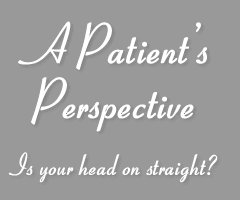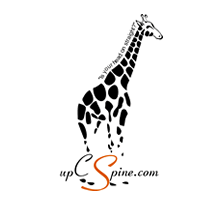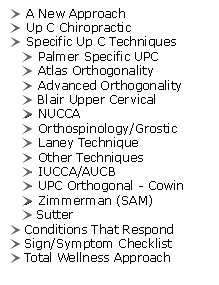

 |
 |
|
Home | A New Approach | Up C Chiropractic UPPER CERVICAL ‘SPECIFIC’
CHIROPRACTIC METHODS, TECHNIQUES & APPROACHES INTRODUCTION to UPPER CERVICAL TECHNIQUES True UpC chiropractors don’t just grab your head and twist your neck ‘hoping’ to unlock, some ‘locked’ vertebrae. Nor do they crack, crunch, rotate, or take your neck to its full range of motion and move it with high velocity in the other direction. This type of approach is what I would call manipulation and I have doubts about the efficacy of such approaches. UpC chiropractors on the other hand are very deliberate and very measured in their approach. They measure displacements in UpC vertebrae with accuracy, utilising precision X-rays to analyse such displacements thoroughly in order to determine the best direction of the adjusting force to achieve the best result possible. This ‘specific’ before and after measurement and correction is the hallmark of the UpC chiropractor and determines the difference, in my opinion between manipulation and adjustment. In the following article Dr. Daniel O. Clark, D.C. www.uppercervicalillustrations.com describes in his own words his very first upper cervical spinal correction. Speak to any patient who has had a ‘specific’ upper cervical spinal correction or adjustment and you will find a very common thread.
Yes, I now understand why the Upper Cervical Spinal Correction is a specialty in the field of Chiropractic – no jerking, twisting or cracking; just a gentle touch on the side of the neck that is barely felt. This is possible because of the precision x-ray analysis, prior to the correction, that provided the Doctor with the exact formula used for the correction. The formula was engineered for my individual correction. No two formulas are the same; each one is developed for that individual person. As soon as the spinal correction is made and Body Balance is restored, muscles relax, blood and oxygen circulation increase, healing messages flow from the brain to the affected area, and the body’s self-healing process is reactivated. The first four to six weeks after the correction is the body’s stabilization and healing period as it adapts to the new balanced, relaxed condition. Listed below are some of the reactions and changes that are possible during the stabilization and healing period, as the body is at work restoring health:
Symptoms may decrease immediately or pain may change and move to another area of the body. All are signs that indicate the self-healing process is working. Most patients get results with the first spinal correction and will experience 85% or better results during the 4 to 6 weeks stabilization and healing period – provided Body Balance is maintained. It is very important for the Doctor to continue to monitor progress during this period to prevent any interruption of the healing cycle. When the body fully adapts to the Upper Cervical Spinal Correction, renewed health is assured. HOW GREAT IS THY ART? Chiropractic is a philosophy, science and art. The philosophy is our core beliefs, which maintain that optimum nerve function is vital to good health and that the nerve function can have interference and this interference can be removed. There are as many ways to describe this as there are chiropractors, but basically most of us are in agreement. The science is the mathematical determination of the structural integrity of the human body. It also addresses the postural standards as to what is normal and optimum to achieve normal nerve function. The art is the skill with which we render service to the patient in restoring nerve function in the pursuit of better health. Someone estimated that there are over 150 different techniques in the country. I think that there are really two major procedures, the manipulators and the specific adjusters. There is a difference. To manipulate, you move structure randomly. To adjust, you move structure from a given place to a different given place. Unfortunately, the vast majority of chiropractic practices consist of manipulation. The time is here when the powers that be, the government,
insurance companies, etc. are asking: "What do you chiropractors
do?" Our answer is: "We correct spinal distortions." But
do we? Can you prove it? Do you take pre and post x-rays? If not, what
is your method of evaluation? I have heard claims of everything up to 100% on nearly all cases. I have yet to see proof of this kind of performance. Dr. John D. Grostic told me his father had about 87% overall average correction. This was a surprise to me in view of the fact that adjusting me, he hit 100% almost every time. It doesn't tell us much if you show a case of 100% correction,
but it will give a picture of your performance if you show a dozen consecutive
cases with close proximity dates on the film. |